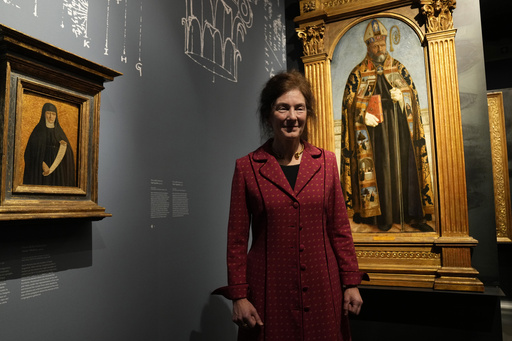MILAN (AP) — An unprecedented exhibition opening Wednesday at the Poldi Pezzoli Museum in Milan reunites for the first time in over 450 years eight surviving panels of the Augustinian Altarpiece by the early Italian Renaissance master Piero della Francesca, while possibly solving one of its enduring mysteries.
Museums have tried and failed in the past to assemble the remaining eight panels, spread among five museums in Europe and the United States, of the original 30-piece polyptych. They include the Poldi Pezzoli, owner of one panel, in 1996 and the Hermitage in St. Petersburg, Russia in 2018.
The Frick Collection in New York, owner of four panels, came closest a decade ago, gathering six.
Poldi Pezzoli Museum director Alessandra Quarto succeeded this time, after learning The Frick Collection would be closed for six months. With the works headed to storage, the New York museum agreed to the loan, making it easier to bring on board museums in London, Washington, D.C. and Lisbon.
In the exhibition, four large panels of saints are staggered against a blue background, flanking a blank wall where the missing central panel would have been. The piece has been missing for centuries and no sketches or records of its subject exist.
“What jumps out is the art and the exuberant monumentality of Piero della Francesca, because the whole is much more than the sum of its parts,’’ said co-curator Machtelt Bruggen Israels of the University of Amsterdam. “The research we have done have allowed us to reveal the biggest mystery that remained around this work.’’
New evidence gathered during scientific study leading up to the exhibition indicates that the missing central panel depicted the coronation of the Virgin, not as long believed the Virgin and Child enthroned, Israels said.
Infrared and stereomicroscopic studies revealed traces of two wings, one pink, one blue, on panels that would have flanked the central piece, indicating angels. The wings, Israels said, would have been scraped off when the altarpiece was disassembled, the wing fragments no longer making sense.
Experts also detected the image of a foot beneath a brocade dress on the left panel, the National Gallery, London’s St. Michael the Archangel, suggesting a kneeling central figure of the Virgin. A similar step and corresponding angel wing is found on the opposite panel, The Frick Collection’s St. John the Evangelist.
The angels, together with the kneeling Virgin, are typical of depictions of the coronation. Until the new study, the pink and blue paint fragments of the wings had been detected, but not fully understood, said co-curator Nathaniel Silver of the Isabella Stewart Gardner Museum in Boston.
“It was a huge ah-a!,’’ Silver said. “It was one of these things that had come up previously as an idea, but there wasn’t the surviving technical evidence to add to the argument.”
Curators maintain a very cautious optimism that the new exhibition, which runs through June 24, could lead to the rediscovery of missing pieces.
Augustinian hermits in della Francesca’s native Borgo San Sepolcro commissioned the altarpiece in 1454, and it hung in its original church for less than 100 years. It was disassembled sometime after being moved to another church, as such depictions fell out of favor, Israels said. A panel showed up in a private collection in San Sepolcro as early as 1620.
The four major panels in the exhibition turned up in Milan in the 1800s. The whereabouts of only other panel, a smaller piece, was noted around the same period, Israels said, adding with a laugh, “therefore I trust that maybe it can be found once again on the ancient market in Milan.”
But most of the others — including the prized central panel — have been lost from view for centuries.
“I think it is very difficult, but not impossible” that missing panels could resurface, said Xavier Salomon, deputy director and chief curator of The Frick Collection in New York. “The last time any of these were seen together was probably here in Milan. So, I would just suggest to anyone who has an attic in Milan, to have a look around.”
This website uses cookies so that we can provide you with the best user experience possible. Cookie information is stored in your browser and performs functions such as recognising you when you return to our website and helping our team to understand which sections of the website you find most interesting and useful.
